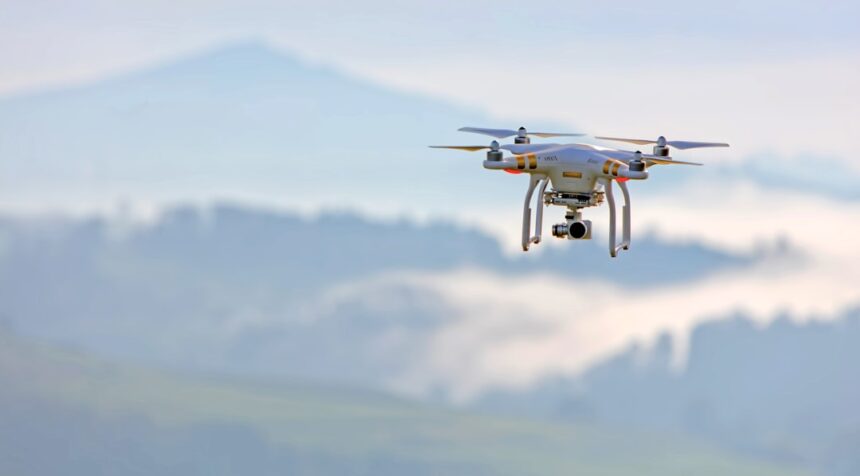In recent years, the proliferation of drone technology has transformed numerous sectors, marking a significant shift in how businesses operate. Initially developed for military applications, drones have found their way into civilian use, becoming indispensable tools across various industries. The rise of drones can be attributed to advancements in technology, including improved battery life, enhanced imaging capabilities, and sophisticated navigation systems.
As a result, organizations are increasingly adopting drones to streamline operations, reduce costs, and improve efficiency. The versatility of drones has made them appealing to a wide range of industries. From agriculture to logistics, the applications are vast and varied.
Companies are leveraging drones for tasks such as aerial photography, surveying land, monitoring crops, and even delivering packages. This widespread adoption is not merely a trend; it signifies a fundamental change in how industries approach their operations. As businesses continue to explore the potential of drone technology, the landscape of various sectors is evolving rapidly, paving the way for innovative solutions and new business models.
Key Takeaways
- Drones are being increasingly utilized across various industries, including agriculture, construction, film, delivery, search and rescue, environmental conservation, and more.
- In agriculture, drones are revolutionizing the way farmers monitor and manage their crops, leading to increased efficiency and reduced costs.
- The construction and infrastructure sector is benefiting from drones by using them for surveying, mapping, and monitoring construction sites, resulting in improved safety and productivity.
- Drones have made a significant impact on the film and entertainment industry by providing unique aerial shots and reducing production costs.
- The delivery and logistics industry is being transformed by drones, offering faster and more efficient delivery options, especially in remote or hard-to-reach areas.
How Drones are Changing the Landscape of Agriculture
In the agricultural sector, drones are revolutionizing traditional farming practices by providing farmers with unprecedented insights into their crops. Equipped with high-resolution cameras and sensors, drones can capture detailed images of fields, allowing farmers to monitor crop health, assess irrigation needs, and identify pest infestations. This data-driven approach enables farmers to make informed decisions that enhance productivity and sustainability.
By utilizing drones, farmers can cover vast areas in a fraction of the time it would take using conventional methods, thereby increasing efficiency and reducing labor costs. Moreover, drones facilitate precision agriculture, a practice that optimizes field-level management regarding crop farming. By analyzing aerial imagery and data collected by drones, farmers can apply fertilizers and pesticides more accurately, minimizing waste and environmental impact.
This targeted approach not only boosts yields but also promotes sustainable farming practices. As the global population continues to grow, the demand for food will increase, making the role of drones in agriculture even more critical in ensuring food security while preserving natural resources.
Drones in the Construction and Infrastructure Sector

The construction and infrastructure sector has also embraced drone technology, recognizing its potential to enhance project management and safety. Drones are employed for site surveys, enabling construction managers to gather accurate topographical data quickly. This information is crucial for planning and executing projects efficiently.
By providing real-time aerial views of construction sites, drones help teams monitor progress, identify potential issues early on, and ensure that projects stay on schedule and within budget. Additionally, drones play a vital role in enhancing safety on construction sites. They can be used to inspect hard-to-reach areas, such as rooftops or tall structures, reducing the need for workers to perform dangerous tasks at heights.
This not only minimizes the risk of accidents but also allows for more thorough inspections without disrupting ongoing work. As the construction industry continues to evolve, the integration of drone technology is expected to become increasingly prevalent, driving innovation and improving overall project outcomes.
The Impact of Drones on the Film and Entertainment Industry
| Impact of Drones on Film and Entertainment Industry |
|---|
| 1. Cost Reduction in Aerial Shots |
| 2. Increased Safety for Crew and Equipment |
| 3. Flexibility in Filming Locations |
| 4. Unique and Dynamic Cinematography |
| 5. Time Efficiency in Production |
The film and entertainment industry has experienced a significant transformation due to the advent of drone technology. Drones have opened up new possibilities for filmmakers by providing unique aerial perspectives that were once only achievable through expensive helicopter shots or cranes. With their ability to capture stunning visuals from various angles and heights, drones have become an essential tool for cinematographers looking to enhance storytelling through dynamic imagery.
Moreover, the use of drones has democratized filmmaking by making high-quality aerial footage more accessible to independent filmmakers and content creators. The affordability and ease of use associated with consumer-grade drones have empowered a new generation of storytellers to experiment with aerial shots without breaking the bank. As a result, audiences are treated to a diverse array of creative content that showcases innovative filming techniques and breathtaking visuals.
Drones Revolutionizing the Delivery and Logistics Industry
The logistics industry is undergoing a significant transformation with the integration of drone technology into delivery systems. Companies are exploring the potential of drones to expedite package delivery, particularly in urban areas where traffic congestion can lead to delays. By utilizing drones for last-mile delivery, businesses can reduce delivery times significantly while also lowering transportation costs.
This shift not only enhances customer satisfaction but also streamlines supply chain operations. Furthermore, drone delivery systems have the potential to reach remote or underserved areas where traditional delivery methods may be inefficient or impractical. For instance, medical supplies can be delivered quickly to rural communities using drones, ensuring that essential items reach those in need without delay.
As companies continue to invest in drone technology for logistics purposes, the landscape of delivery services is likely to evolve dramatically, paving the way for faster and more efficient solutions.
The Role of Drones in Search and Rescue Operations

Drones have emerged as invaluable assets in search and rescue operations, providing critical support during emergencies. Equipped with thermal imaging cameras and GPS technology, drones can quickly survey large areas in search of missing persons or assess disaster-stricken regions. Their ability to cover vast distances in a short amount of time allows rescue teams to gather vital information that can inform their strategies and improve response times.
In addition to their speed and efficiency, drones can access hard-to-reach locations that may pose risks to human rescuers. For example, during natural disasters such as floods or earthquakes, drones can navigate hazardous environments to locate survivors or assess damage without putting lives at risk. As technology continues to advance, the role of drones in search and rescue operations is expected to expand further, enhancing emergency response capabilities and saving lives.
Drones in Environmental Conservation and Monitoring
Environmental conservation efforts have greatly benefited from the use of drone technology. Drones equipped with advanced sensors can monitor ecosystems, track wildlife populations, and assess environmental changes over time. This capability allows researchers and conservationists to gather data that informs their efforts to protect endangered species and preserve natural habitats.
By providing real-time insights into environmental conditions, drones play a crucial role in promoting sustainable practices. Moreover, drones are instrumental in combating illegal activities such as poaching and deforestation. By conducting aerial surveillance over protected areas, conservation organizations can deter illegal activities and respond swiftly when violations occur.
The ability to monitor vast expanses of land from above enhances enforcement efforts while minimizing human intervention in sensitive ecosystems. As awareness of environmental issues grows, the integration of drone technology into conservation strategies is likely to become increasingly important.
The Legal and Ethical Considerations of Drone Use
As drone technology continues to advance and proliferate across various industries, legal and ethical considerations have come to the forefront of discussions surrounding their use. Regulatory frameworks governing drone operations vary significantly from one country to another, leading to confusion among users regarding compliance requirements. Issues such as airspace regulations, privacy concerns, and liability in case of accidents must be addressed to ensure safe and responsible drone usage.
Concerns about surveillance capabilities and potential invasions of privacy have sparked debates about the appropriate use of drones in both commercial and recreational contexts.
The Future of Drones: Advancements and Innovations
The future of drone technology holds immense promise as advancements continue to emerge at a rapid pace. Innovations such as artificial intelligence (AI) integration are set to enhance drone capabilities further by enabling autonomous flight operations and advanced data analysis. These developments will allow drones to perform complex tasks with minimal human intervention while improving accuracy and efficiency.
Additionally, advancements in battery technology are expected to extend flight times significantly, enabling drones to cover larger areas without needing frequent recharges. As research into new materials progresses, lighter yet more durable drones may become commonplace, enhancing their performance across various applications. The future landscape of drone technology is likely to be characterized by increased automation, improved safety features, and expanded applications across diverse industries.
The Challenges and Concerns Surrounding Drone Technology
Despite the numerous benefits associated with drone technology, several challenges and concerns persist that must be addressed for its continued growth and acceptance. One significant challenge is the issue of airspace congestion as more drones take to the skies for commercial purposes. Ensuring safe integration into existing air traffic systems will require collaboration between regulatory bodies, industry stakeholders, and technology developers.
Moreover, public concerns regarding privacy violations remain a significant barrier to widespread acceptance of drone usage. As drones become more prevalent in everyday life—whether for deliveries or surveillance—addressing these concerns through transparent regulations will be crucial for fostering public trust. Additionally, ensuring cybersecurity measures are in place to protect against potential hacking or misuse is essential for safeguarding sensitive data collected by drones.
The Potential Economic and Social Impact of Drones
The economic implications of drone technology are profound as industries continue to adopt these innovative tools for various applications. By increasing efficiency and reducing operational costs across sectors such as agriculture, logistics, construction, and entertainment, drones have the potential to drive significant economic growth. Job creation within the drone industry itself—ranging from manufacturing to piloting—will contribute further to economic development.
Socially, the integration of drones into everyday life has the potential to enhance quality of life by improving access to services such as healthcare delivery in remote areas or facilitating faster emergency response times during crises. As communities embrace drone technology for various purposes—from environmental monitoring to recreational use—their impact on society will likely be transformative. Ultimately, as industries continue to explore the possibilities offered by drones, their economic and social contributions will shape the future landscape in ways that are yet to be fully realized.
In the rapidly evolving landscape of modern technology, drones have emerged as a disruptive force, reshaping industries from agriculture to logistics. Their ability to perform tasks with precision and efficiency has made them indispensable tools in various sectors. A related article that delves into the transformative impact of drones is available on In The War Room. This article explores the multifaceted applications of drones and how they are redefining traditional practices, offering insights into the future of this groundbreaking technology.
FAQs
What is a drone?
A drone, also known as an unmanned aerial vehicle (UAV), is an aircraft without a human pilot on board. Drones can be remotely controlled or can fly autonomously through software-controlled flight plans.
How are drones being used in various industries?
Drones are being used in a wide range of industries including agriculture, construction, filmmaking, surveillance, search and rescue, and package delivery. They are also used for recreational purposes such as photography and racing.
What are the advantages of using drones?
Drones can access hard-to-reach areas, reduce the risk to human life, and provide cost-effective and efficient solutions for various tasks. They can also collect data and provide real-time information for decision-making.
What are the potential disruptions caused by drones?
Drones have the potential to disrupt traditional industries such as agriculture, transportation, and logistics by providing innovative and efficient solutions. They also raise concerns about privacy, security, and airspace regulations.
What are the challenges associated with the widespread use of drones?
Challenges include safety concerns, regulatory issues, public acceptance, and the need for infrastructure to support the integration of drones into existing systems. Additionally, there are concerns about the potential misuse of drones for malicious purposes.




